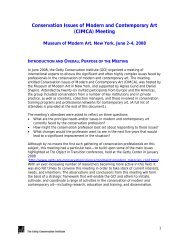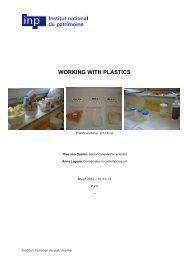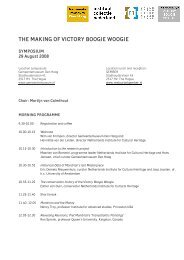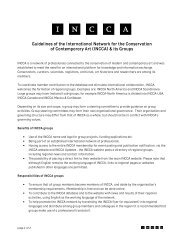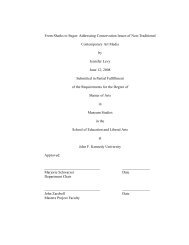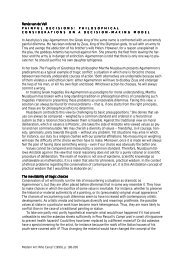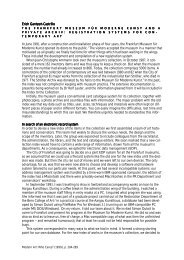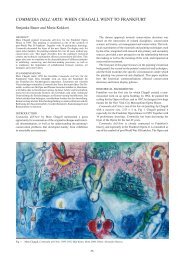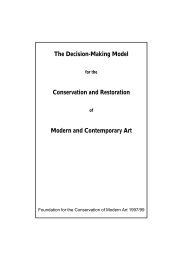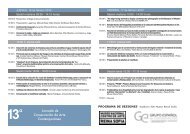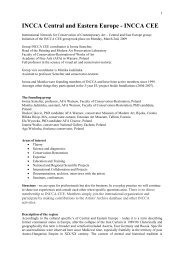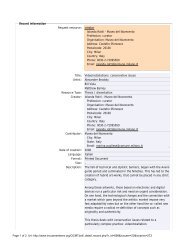to download - incca
to download - incca
to download - incca
Create successful ePaper yourself
Turn your PDF publications into a flip-book with our unique Google optimized e-Paper software.
What the INCCA-CEE group has been up <strong>to</strong> and is planning for the future.<br />
on INCCA-CEE activities in INCCA net and public area(September 2011):<br />
The members of Group INCCA-CEE participated in Seminar Acces2CA in<br />
December 2009 in Liubljana, they have continued a new subproject of<br />
PRACTIC‘s titled : “IACCMA; Innovative Approach <strong>to</strong> the Complex Care of<br />
Modern Art”<br />
INCCA-CEE organized panel in June 2010 during Symposium Contemporary Art:<br />
Who Cares? and participated in Seminar Acces2CA in March 2011 in Por<strong>to</strong>.<br />
Together with colleagues we published many articles in professional magazines.<br />
Moreover in the nearest future we are going <strong>to</strong> publish selected materials from<br />
INCCA-CEE activities in the common book titled: “The Knowledge Tree;<br />
Innovative Approach <strong>to</strong> the Complex Care of Modern Art”, ed. Iwona<br />
Szmelter, by AFA Publisher, Warsaw & Archetype, London, (in print)<br />
Miroslaw Balka – INCCA‟s research first hero‟s retrospective projects:<br />
Mirosław Balka: Arbeitsplatz, The Salon of the Academy, Warsaw, May-June<br />
2011, detail form exhibition presented kinetic self-portrait of artist is below)<br />
Dedicated <strong>to</strong> Memory - European Culture Congress, Wroclaw.September 2011,<br />
Miroslaw Balka‟s legacy was a first and common INCCA case study of the<br />
care of his artworks in different museums (see below)*. In last twenty years<br />
Balka realised many complex artworks in the whole world. His last exhibition<br />
Arbeitsplatz, (German, ―workplace‖) is a culminating point. Mirosław Bałka presents<br />
a new project, realized with the team in cooperation with cura<strong>to</strong>r-conserva<strong>to</strong>r Iwona<br />
Szmelter in Salon Akademii gallery. His name is familiar <strong>to</strong> his<strong>to</strong>rians, cura<strong>to</strong>rs,<br />
critics and collec<strong>to</strong>rs of contemporary art. The artist‘s works are held by major<br />
international art collections, including the Tate Gallery (London), Hishhorn Museum<br />
and Sculpture Garden (Washing<strong>to</strong>n), Museet for Samtidkunst (Oslo), Stedelijk Van<br />
Abbemuseum (Eindhoven), The Museum of Contemporary Art (Los Angeles), Kaiser<br />
Wilhelm Museum (Krefeld), Museum of Modern Art (New York), Muzeum Sztuki<br />
(Lodz). His recent works include the famous How It Is in the Turbine Hall, Tate<br />
Modern in London (2009/2010), and the Fragment, a retrospective exhibition of<br />
video works at the Centre for Contemporary Art in Warsaw (January-April 2011),<br />
project Ctrl, prepared by the Museo Reina Sofia and exhibited simultaneously in two<br />
places: Museo Reina Sofia in Madrid and at the Benedictine Abbey of San<strong>to</strong> Domingo<br />
de Silos (2010-2011), in the province of Burgos, Northern Spain.
In 2011 Arbeitsplatz project was type of long-term project combined pre-<br />
acquisition activities, production of kinetic elements, the presentation and care of<br />
artist‘s current artworks. It was an opportunity <strong>to</strong> reflect not only on the artist‘s ‗place<br />
of work‘, but also the role of creative process, the discussion of the intents of author,<br />
future of artworks, retrospection of artist‘s path. Cura<strong>to</strong>r (Iwona Szmelter) realised<br />
project <strong>to</strong>gether with artist, made a documentation and catalogue; this multiple role<br />
was based on Arbeitsplatz as a paraphrase, freely developing and modifying the<br />
original content, while preserving its essential meaning. It refers <strong>to</strong> the famous debut<br />
project, Souvenir of the First Holy Communion (1985), created as a degree piece at<br />
the Faculty of Sculpture, Academy of Fine Arts in Warsaw. Balka‘s kinetic and<br />
vertical self-portrait is fragment of complex artwork (pho<strong>to</strong>s below, by I.Szmelter).
This time he presents sculptures in the space of his studio, their three-dimensionality<br />
enriched by the fourth dimension, that is time – through which he pays tribute <strong>to</strong> his<br />
workplace. Equally valuable and important as the principal artistic goal is the road<br />
leading <strong>to</strong> its carrying out. Invoking a symbolic ―workplace‖ Balka provokes<br />
reflection, as he makes it almost intangible in its expression, like the Japanese poetic<br />
form of haiku, <strong>to</strong> which the artist refers in a number of his sculptural projects. This<br />
gentle form becomes concretized through the viewer‘s perception. He at the same<br />
time suggests certain contexts, symbolic or his<strong>to</strong>rical, material connotations and even<br />
their address. For Balka memory plays unique and multiple roles. It helps the artist <strong>to</strong><br />
define his roots and <strong>to</strong> introduce both traditional and new art forms in<strong>to</strong> his diverse<br />
works, including video images.<br />
Miroslaw Balka‘s artworks, dedicated <strong>to</strong> memory, are invited for European Culture<br />
Congress, 8-11.09.2011 in Wroclaw.<br />
Ed. Iwona Szmelter
Notes from INCCA archive *<br />
http://www.icn.nl/dir003/icn/cmt/text.nsf/URL/865AB05822BDCCC6C125700D0<br />
029F503/$FILE/tatjascholte1.pdf, access 10.09.2009; Miroslav Balka, 1120 x 875 x<br />
2, National Zachęta Gallery, Warsaw, 2000, floor covered with Polish house hold<br />
soap + INCCA Interview with Miroslav Balka, Academy of Fine Art, Warsaw<br />
Archief Miroslav Balka 2001; Quotation from interview with Miroslav Balka, by<br />
Iwona Szmelter, AFA, Warsaw (23.3.2001) ―We can feel the irritating scent of cheap,<br />
grey, household soap all over the room. Earlier the soap was specially prepared in<br />
bricklayer's tubs by abrasion on the grate, mixing it with water <strong>to</strong> obtain the paste<br />
consistency and put it with spatulas on the huge surface (about 180m2). They<br />
s<strong>to</strong>pped producing that kind of soap, changing its scent in<strong>to</strong> a more fragile one.There<br />
are cubes of soap from a Czech brand -"Extra Jeleñ". Finally I found the soap again in<br />
Poland, in Otwock. It rescued that work.‖<br />
The conservation of ―211 x 179 x 125, 190 x 129 x 73‖, Kröller-Müller Museum,<br />
Otterlo, Reaction <strong>to</strong> the article ‗Conservation of ―211 x 179 x 125, 190 x 129 x 73‖-<br />
Conservation issues in 'La Caixa' Miroslav Balka, River, 1988-89 Van Abbemuseum,<br />
Eindhoven, painted jute, neon, ash, wood. Guidelines based on correspondence with<br />
Miroslav Balka, by Hester S<strong>to</strong>ebe, MUMOK, Vienna.<br />
ALINA SZAPOCZNIKOW, Sculpture Undone, 1955 – 1972;<br />
Series of presentations of artist‟s avant-garde legacy during 2011-2013<br />
Brussels WIELS Contemporary Art Centre opens its season with the premiere of an<br />
expansive solo exhibition of Polish sculp<strong>to</strong>r Alina Szapocznikow (1926–1973).<br />
http://www.wiels.org/site2/home.php?lng=en This major event- after long-term<br />
conservation-res<strong>to</strong>ration project, is the fruit of an exceptional collaboration initiated<br />
by WIELS and the Museum of Modern Art in Warsaw and concentrates in particular<br />
on artist‘s late period from 1955 <strong>to</strong> her untimely death in 1973, at age 47. As a<br />
sculp<strong>to</strong>r Szapocznikow's progressive development was <strong>to</strong>wards a conception of<br />
sculpture as an imprint not only of memory but of her own body left behind a legacy<br />
of provocative objects—at once sexualized, fragmented, vulnerable, humorous, and<br />
political—that still sit between Surrealism, Nouveau Realisme, and Pop Art. Her
tinted polyester casts of her lips and breasts transformed in<strong>to</strong> quotidian objects like<br />
lamps or ashtrays, her poured polyurethane forms, and her construction of sculptures<br />
that incorporate pho<strong>to</strong>graphs remain as remarkably idiosyncratic and contemporary<br />
<strong>to</strong>day. In the nearest future the exhibition will travel <strong>to</strong> the Hammer Museum, Los<br />
Angeles (February 5–April 29, 2012), the Wexner Center for the Arts, Columbus,<br />
Ohio (May 19–August 5, 2012), and The Museum of Modern Art, New York (Oc<strong>to</strong>ber<br />
7, 2012–January 28, 2013) after the WIELS showing, which will be the only<br />
European venue for the exhibition. http://www.e-flux.com/shows/view/10007 .<br />
Short report about pioneer‟s conservation of complex issues of material<br />
and intangible heritage and plastic artworks is below:<br />
Immortality/Mortality: Preservation of the Avant-garde Legacy of Alina<br />
Szapocznikow; Iwona Szmelter & conservation interdisciplinary team<br />
To preserve Alina Szapocznikow's avant-garde and very destroyed more than 100<br />
artworks, in the project of conservation we under<strong>to</strong>ok the challenge of exhibiting her<br />
works in the form most representative of her intentions, despite of transgression.
Alina Szapocznikow‘s work demonstrates a wide range of techniques and<br />
technologies: from plaster, bronze, and marble <strong>to</strong> deep-dyed polyesters,<br />
polyurethanes, inserts – ready-made, non-permanent organic ones, such as grass and<br />
newspaper. Many of the artist‘s works were in pieces, like jigsaw puzzles (pho<strong>to</strong><br />
below).<br />
They were covered with grey residue, which provoked a metaphorical mis-<br />
interpretation of ―cancerous growth‖. In addition <strong>to</strong> the considerable material<br />
damage, her works have been often misinterpreted. For the 25th anniversary of her<br />
death, in 1998, a great retrospective was organized which included all the creative<br />
phases in the sculp<strong>to</strong>r‘s lifetime. The catalogue mentions over 500 objects, 129 of<br />
which, mostly plastic‘s, have res<strong>to</strong>red by Iwona Szmelter and Olgierd Guminski<br />
(1994-1998) with the help of an interdisciplinary team of researchers. It was a really<br />
pioneer‘s project in the synthetic‘s identifications and conservation-res<strong>to</strong>ration.<br />
Subsequently another 12 of Szapocznikow‘s artworks were conserved with the help of<br />
innovative technologies of preservation, conservation and res<strong>to</strong>ration by the same
team and 2 object‘s conserved by students in theirs MA degree‘s:, Aga Wielocha, Ula<br />
Kusz.<br />
Preliminary research was based on an investigation of the documentation of the<br />
artist's work, her public speeches, interviews. Mr Piotr Stanisławski, Szapocznikow‘s<br />
son, heir and partner in last realizations was consulted on some essential and<br />
technical issues. Consultations with chemists confirmed what type of material was<br />
used. These findings created a basis for the verification of a description of the<br />
technique and technology used in Alina Szapocznikow's work and methodology for<br />
care of her legacy and conservation, including preservation of synthetic resin. .<br />
Concluding, the main goal of the preservation of the legacy of Alina Szapocznikow is<br />
<strong>to</strong> save and transmit not merely the de-contextualized fragments but their essence.<br />
The difficulties in sustaining the complexity of the ideas and meaning of her<br />
artworks: while simultaneously preserving their authentic matter, including<br />
impermanent particles of polyesters, polyurethanes, plants, green grass, etc. Our<br />
ethical considerations related <strong>to</strong> dematerialisation, lifetime of intangible elements.<br />
We did a ‗conservation through<br />
documentation and reconstructions,<br />
reconsidering issues of authenticity<br />
versus emulation of ephemeral parts,<br />
such as grass, etc. The duplication<br />
problems and replacement of "ready-<br />
mades" in art has brought us again<br />
back <strong>to</strong> the authenticity issues; a very<br />
circle of Aris<strong>to</strong>telian classification of<br />
art, with an evident precedence of an<br />
idea over its reflection in the object,<br />
i.e. in matter. Much attention has<br />
been paid <strong>to</strong> the legal consequences,<br />
the so-called ―right <strong>to</strong> integrity‖ and<br />
Alina Szapocznikow‘s copyright.
Ed. Iwona Szmelter ( fragment of lecture presented in ―Contemporary Art: Who<br />
Cares?‖, Amsterdam, 2010)<br />
CEE - project: Preserve the Foksal Gallery’s Heritage<br />
Conservation-res<strong>to</strong>ration project, conservation treatment of 20 objects – co-<br />
operation of Poland-Lituanian team with co-operation with Es<strong>to</strong>nia : M. Jadzinska (<br />
pho<strong>to</strong> below), I. Szmelter (Acedemy of Fine Arts, Warsaw, Poland), S. Gotautaite<br />
(Lituania), Foksal Gallery played an extraordinary role in the art landscape of Central<br />
and East Europe from 60-ties, as a window opened for the rest of the world, as a<br />
point between West an East, Soviet Bloc and the others. 20 mentioned objects<br />
represent the conceptual art, belonging mainly in<strong>to</strong> the The living Archive. The<br />
conservation was done for the exhibition in: KUMU, Es<strong>to</strong>nia, 2010.<br />
The opening of MOCAK – the Museum of Contemporary Art in Krakow –<br />
on 19th May 2011<br />
The specific character of an institution which interactively participates in the creative<br />
process of art relies on skillful and, indeed, unceasing, reflection on its own role and<br />
character in order <strong>to</strong> allow access <strong>to</strong> new strategies for action designed <strong>to</strong> reach out <strong>to</strong><br />
various sec<strong>to</strong>rs of the audience. The fortui<strong>to</strong>us location of the Museum, outside<br />
Krakow‗s epicentre, and in Schindler‗s former fac<strong>to</strong>ry – a space easily identifiable all<br />
over the world – will favour an in-depth contact with art. MOCAK will carry out the<br />
tasks typically expected of a critical museum. Whilst giving a preferential treatment<br />
<strong>to</strong> artists, we must not exclude the viewer. We will ensure that each exhibition<br />
receives a suitable interpretative context. For our Museum, its contemporary quality<br />
means showing and interpreting the world via art, rather than exhibiting art his<strong>to</strong>ry.<br />
To function in the global art network obliges us <strong>to</strong> be open and <strong>to</strong> coexist on equal<br />
rights with both the local and the universal. Do visit us!<br />
The MOCAK Team in :// www.mocak.com.pl
Detail from permanent exhibition; Robert Kusmirowski, Untitled, 2009, installation.<br />
Objects the primary function of which was <strong>to</strong> provide a cure, appear as <strong>to</strong>xic and<br />
harmful.<br />
MOCAK - Journey East - info :<br />
02.12.2011-29.01.2012 Exhibition place: MOCAK- Museum of Contemporary<br />
Art in Krakow. Author‟s : CEE group exhibition; Cura<strong>to</strong>r: Anna Łazar, Monika<br />
Szewczyk; www.mocak.com.pl/en/exhibitions<br />
Description: artists from Armenia, Azerbaijan, Belarus, Georgia, Moldova, Ukraine<br />
and Poland will be invited <strong>to</strong> take part in the exhibition "Journey East". We shall<br />
neither attempt <strong>to</strong> group works according <strong>to</strong> their nationality, nor pretend that the<br />
issue of national identity and national belonging is invisible. A young state and the<br />
his<strong>to</strong>ry of a country do affect the condition of art in that country. After all, artistic<br />
activity depends not only on the artist‘s own resources, but also on the artistic<br />
educational and other institutions which support the process of the production and<br />
exhibition of works, but also on the size of the artistic community and the presence of<br />
cura<strong>to</strong>rs and art critics. We have received signals from the majority of the participant<br />
countries that these are vital issues. For this reason, we ask artists what inspires them<br />
in their particular place and time.<br />
Edwin Bendyk prophesies that the solution <strong>to</strong> global woes is <strong>to</strong> create interpersonal<br />
relationships based on love, and not on competition, hierarchy or domination. The<br />
focus is on love which goes beyond a feeling between any two people; we are looking<br />
for positive emotions, which often create bonds between people all over the world<br />
which can provide an alternative <strong>to</strong> those mediated by the state or the market. We
want <strong>to</strong> ask artists what role, in their opinion, such emotions play in a post-<br />
communist society and whether they regard building new social capital on positive<br />
relations as U<strong>to</strong>pian – or whether, indeed, such a notion is realistic. We perceive our<br />
project as an open situation, mapping out diverse paths for participation and<br />
interpretation: from observation and listening <strong>to</strong> conversation, from co-operation <strong>to</strong><br />
sharing in writing. We will be collecting objects and organising meetings, discussions,<br />
workshops, performances and installations in public spaces.<br />
The exhibition will be presented in the Arsenal gallery in Bialys<strong>to</strong>k in August and<br />
September, and subsequently in the Art-Kyiv Contemporary and in the Museum of<br />
Contemporary Art in Krakow. The artists we have invited:<br />
Armenia: Vahram Aghasyan, Ruben Arevshatyan, Samvel Baghdasaryan, Arman<br />
Grigoryan, Armine Hovhannisyan, Tigran Khachatryan;Azerbaijan: Rashad<br />
Alakbarov, CHINGIZ, Babi Badalov, Orkhan Huseynov, Sabina<br />
Shikhlinskaya;Belarus: Anna Chkolnikova, Aleksander Komarov, Marina<br />
Naprushkina, Sergey Shabohin, Oleg Yushko;Georgia: Bouillon Art Group, Lado<br />
Darakhvelidze, Elene Rakviashvili, Nino Sekhniashvili, Sophia Tabatadze; Moldova:<br />
Veaceslav Druta, Tatiana Fiodorova, Maxim Kuzmenko, Dumitru Oboroc, Stefan<br />
Rusu; Ukraine: Ana<strong>to</strong>liy Byelov, Alevtina Kakhidze, Maria Yaroslava Khomenko,<br />
Volodymyr Kuznetsov, Stas Volyazlovsky, TanzLabora<strong>to</strong>rium; Poland: Alicja<br />
Bielawska, Kuba Dąbrowski, Nicolas Grospierre, Elżbieta Jabłońska,Dominik<br />
Jałowiński, Anna Molska, Joanna Rajkowska, Jakub Szczęsny.<br />
Project „s within the Polish Presidency of the EU Council<br />
In view of the growing importance of<br />
the Visegrad cooperation, being a substantive contribution from V4 <strong>to</strong> the issues of<br />
the European cultural heritage, the Forum should become a voice of Central Europe,<br />
<strong>to</strong> be heard in Brussels, on matters of heritage and its protection and management.<br />
The organiser‘s intention is for the first gathering of the Forum <strong>to</strong> bring <strong>to</strong>gether not
only distinguished speakers, specialists from the Czech Republic, Hungary, Slovakia<br />
and Poland, but also <strong>to</strong> encourage participation in this and subsequent events, of<br />
experts and representatives of institutions from other countries of the region.<br />
In line with the wishes of the Ministers of Culture of V4, since 2007, the International<br />
Cultural Centre in Krakow has been the coordina<strong>to</strong>r of a panel of experts in cultural<br />
heritage, and hence, as the starting point for the three days of the Forum, we wish <strong>to</strong><br />
take the proceedings of the conference on ―Protecting and safeguarding cultural<br />
heritage. The systems of management of the cultural heritage in the Visegrad<br />
countries.‖, organised by ICC in cooperation with the Visegrad partners in 2010.<br />
http://www.mck.krakow.pl/<br />
Happening Against Communism by the Orange Alternative<br />
June 19 – Oc<strong>to</strong>ber 2 , 2011<br />
ICC; International Culture Center In Krakow<br />
Contemporary heritage from the 1980s, that is the declining, but also the most<br />
tumultuous years of The Polish People‘s Republic (PRL), the Orange Alternative<br />
entered the streets of the Polish cities.<br />
The exhibition present the his<strong>to</strong>ry of the Orange Alternative, whose happening events<br />
have been a unique phenomenon not only for Poland but in all of Europe. The Orange<br />
Alternative ‖movement‖ initiated in Wrocław has gone down in the awareness of a<br />
generation of Poles. Among the best recognised symbols of the initiative were dwarfs<br />
painted on walls. The Orange Alternative was not only a social movement protesting<br />
against the Polish reality in the 1980s, but above all a force opposing the regime on<br />
the national level, without creating formal structures and voicing political slogans. It<br />
was an alternative for the regime, for the opposition, but also for the drab reality.<br />
The Orange Alternative activists lampooned the pompously celebrated anniversaries,<br />
the convention of official events with a theme, the overwhelming presence of the<br />
police and the secret services in all areas of live, the shortages in shops and so on. The<br />
trademark of the movement was the dwarf (first painted on paint spots covering up<br />
anti-government slogans on city walls) and later a red or orange hat donned by<br />
participants of the happenings. The movement‘s actions poked fun at the regime and<br />
after 1989 they served as a comment on the current political and social situation. The<br />
methods and language used pointed <strong>to</strong> a strong influence of the Dada movement.
The exhibition in the ICC Gallery is the first such an extensive presentation of the<br />
movement. It shows its emergence and development, and the narrative is set against<br />
the backdrop of the political and social his<strong>to</strong>ry of Poland in the 1980s and during the<br />
transition. http://www.mck.krakow.pl/news/dwarfs-in-the-icc<br />
Eastern Dimension of Mobility Conference,<br />
The issues of the care of contemporary art was presented on 6-7 July 2011 during two<br />
sessions: A. Mobility, a vehicle for collaboration in research: Mobility for researchers<br />
in the EaP countries, engagement with ERA through the mobility of researchers; B.<br />
Culture: Mapping of existing <strong>to</strong>ols, researches, information systems, funding<br />
opportunities (including Eastern Partnership Culture Programme, results of the<br />
Special Actions 2009-2010 of the Culture Programme, Civil Society Forum);<br />
The main aim of this meetings is <strong>to</strong> reinforce mobility flows in education, youth,<br />
research and culture between the European Union and Eastern Partnership<br />
countries. Description: One of the most important purposes of the meeting is <strong>to</strong><br />
have a comprehensive presentation of the existing opportunities <strong>to</strong> support mobility,<br />
both through the EU programs as well as through new initiatives. The presentation of<br />
good practices will also take place during the conference. The debates on future<br />
possibilities will contribute <strong>to</strong> the general debate on the shape of the new generation<br />
of EU programmes in the New Financial Perspective 2014-2020. The idea behind the<br />
conference is <strong>to</strong> listen <strong>to</strong> the EaP countries‘ expectations. Organizers: Ministry of<br />
Culture and National Heritage, Ministry of National Education, Ministry of Science<br />
and Higher Education, Ministry of Sports and Tourism, European Commission;<br />
Partners: Adam Mickiewicz Institute, Cultural Contact Point Poland, Europe for<br />
Citizens Contact Point Poland, City of Warsaw. Participants: the overall number of<br />
participants is 300, among them: 180 will come from the Eastern Partnership<br />
countries, 120 will come from the EU countries Participants profile:<br />
representatives of the relevant ministries, universities, research centres, national<br />
agencies of EU programmes, youth, students, teachers' associations, foundations,<br />
cultural associations and institutions as well as sport movement. http://www.eap-<br />
mobility.pl/en
CEE- activity as partners in »EU Cultural Heritage Identity Card« (EU-<br />
CHIC) project<br />
Identifies and summarises the methods, techniques and <strong>to</strong>ols used by various<br />
information systems in recording data on cultural heritage (Poland is responsible for<br />
Central and Eastern Europe countries: Poland, Es<strong>to</strong>nia, Latvia and Lithuania).<br />
The »EU Cultural Heritage Identity Card« (EU-CHIC) project will propose a strategy<br />
and systems for the most efficient methods and <strong>to</strong>ols of harmonising criteria and<br />
indica<strong>to</strong>rs for tracking changes and interventions on the tangible cultural heritage<br />
across Europe and its neighbouring countries. The project results will demonstrate a<br />
significant cost-benefit advantage for owners, managers, authorities and conserva<strong>to</strong>rs<br />
in charge of protecting Europe's immovable cultural assets. It will also create the<br />
capability <strong>to</strong> moni<strong>to</strong>r and systematically report on various human and natural<br />
impacts on the physical state of that heritage, and assist in the provision of the most<br />
relevant and economic choices for effective preventive conservation. The main<br />
objective of EU-CHIC is <strong>to</strong> develop and test guidelines, required for the efficient<br />
compilation and s<strong>to</strong>rage of data, pertinent <strong>to</strong> each monument and structure under<br />
observation. The EU-CHIC system will support sustainable maintenance, preventive<br />
conservation and the rehabilitation of his<strong>to</strong>ric sites and monuments. The<br />
identification of the MTTs used in the national information systems on cultural<br />
heritage was based on a survey. The partners of the CHIC project responded <strong>to</strong> a<br />
questionnaire in which they listed the MTTs used in the information system. An<br />
overview of methods and <strong>to</strong>ols should provide the basis for assessment and<br />
identification of the most effective MTTs in relation <strong>to</strong> the Cultural Heritage Identity<br />
Card (CHIC). The selection of MTTs, their resolution and precision, varies dependent<br />
upon the reasons, aims and objectives of the information system. The MTTs were<br />
arranged according <strong>to</strong> general categories, and an overview of MTTs used in 11<br />
European countries and Israel is presented in this report, along with the template<br />
tables. (see: reports www.chic-eu.eu).<br />
Dissemination:<br />
Jerzy Szałygin, the Chairman of the Department of Register and Record of<br />
Monuments, National Heritage Board of Poland, Warsaw
Dissemination, meeting 24.06.2010; main objectives were presented and discussed<br />
possible contact with people and organizations from Es<strong>to</strong>nia, Latvia and Lithuania,<br />
connected with cultural heritage and interested in sharing knowledge and experience;<br />
discussing the possibilities of collaboration; first show of scheme of documentation<br />
and records of monuments<br />
meeting, consultation 26.08.2010, 9.09.2010: the structure of the department,<br />
documentation of the cultural heritage through registering the his<strong>to</strong>rical monuments<br />
– their values and condition they are in,<br />
meeting, consultation 16.09.2010, 9.05.2011, 16.05.2011: administration‘s task,<br />
permissions; archiving documental resources that relate <strong>to</strong> the protection of<br />
his<strong>to</strong>rical monuments; pho<strong>to</strong>s of particular documentation<br />
The consortium of the project consists of 12 partners from 11 countries, which are:<br />
Slovenia, Austria, Belgium, Croatia, Czech Republic, Germany, Greece, Israel, Italy,<br />
Poland, and Spain. It will coordinate the activities at the national and international<br />
levels. I addition, the Advisory Committee having members from five countries: Egypt,<br />
France, Norway, Scotland (UK), The Netherlands, is established <strong>to</strong> lead the Advisory<br />
Network. Partners in Poland: IPPT PAN (mgr Marek Sklodowski), AFA Warsaw (dr<br />
Monika Jadzinska),<br />
Workshops (2010-2011): 30. and 31. May 2011 ;Congress Centre, Zdravilińka cesta 24,<br />
Podčetrtek, Slovenia.;Contact: University of Ljubljana, Jamova 2, 1000 Ljubljana,<br />
Slovenia 12 Oc<strong>to</strong>ber 2010, University of Bologna – Ravenna Campus; Venue:<br />
University of Bologna – M2ADL, Te.Co.Re., Via Guaccimanni, 42 48100 Ravenna;29<br />
April 2010; EU-CHIC VIENNA MEETING WORKSHOP; Schloss Schoenbrunn<br />
Kultur; info@eu-chic.eu<br />
Information Society 2011 – 14th International Multiconference, 10-14<br />
Oc<strong>to</strong>ber 2011, Josef Stefan Institute, Jamowa cesta 39, www.is.ijs.si, Ljubliana,<br />
Slowenia.<br />
Paper: ―Safe the Culture and the Culture Safes You. Considerations on the Role of<br />
Culture, Art and their Preservation in Modern Society” M. Jadzinska
The Second International Conference on Cogni<strong>to</strong>nics – a subconference of the<br />
Multiconference "Information Society 2011" (Oc<strong>to</strong>ber 10-11, 2011, Jozef Stefan<br />
Institute, Ljubljana, Slovenia). The goal of the conference is <strong>to</strong> combine the efforts of<br />
the scholars from numerous scientific fields and educa<strong>to</strong>rs in order <strong>to</strong> establish a new<br />
synergy aimed at ensuring the harmonic, well-balanced development of the<br />
personality and national cultures in the modern information society and, as a<br />
consequence, <strong>to</strong> compensate a number of broadly observed negative dis<strong>to</strong>rtions.<br />
Our point was <strong>to</strong> disseminate and exchange the knowledge and experience in the field<br />
of preservation of cultural heritage, first of all - contemporary art, in digital age, when<br />
the personality and national cultures are caused by s<strong>to</strong>rmy development of<br />
informational technologies and globalization processes. The aim of the ICC is <strong>to</strong><br />
formulat a new, large-scale goal for the software industry and Web science: <strong>to</strong><br />
develop a new generation of culture-oriented computer programs and online courses<br />
(in the collaboration with educa<strong>to</strong>rs, linguists, art his<strong>to</strong>rians, psychologists) - the<br />
computer programs and online courses intended for supporting and developing<br />
positively-oriented creativity, cognitive-emotional sphere, the appreciation of the<br />
roots of the national cultures, the awareness of the integrity of the cultural space in<br />
the information society, and for supporting and developing symbolic information<br />
processing and linguistic skills, associative and reasoning abilities of children and<br />
university students.<br />
Co-Chairs: Dr. Vladimir A. Fomichov (*) and Dr. Olga S. Fomichova (**)<br />
(*) Faculty of Business Informatics, State University - Higher School of Economics,<br />
Moscow, Russia; http://www.hse.ru/lingua/en/org/persons/67739;<br />
(**) State Educational Centre "Dialogue of Sciences", Moscow, Russia<br />
Participation in ICT Proposers Day" Conference, hosted in Budapest<br />
Hungary from 19 till 20 May 2011 <strong>to</strong>:<br />
- <strong>to</strong> identify partners and facilitate the setup of FP7 project consortia<br />
-<strong>to</strong> discuss and develop new project ideas on ICT at international level<br />
- <strong>to</strong> initiate cross-border contacts<br />
The ICT Proposers‘ Day 2011 is taking place in Budapest 19-20 May 2011 organised<br />
by the European Commission under the auspices of the Hungarian EU Presidency. It
is dedicated <strong>to</strong> networking and promoting research & development in the field of ICT<br />
within 7th Framework Programme (FP7)<br />
Ideal-ist is organising a brokerage event in cooperation with the Enterprise Europe<br />
Network with pre-arranged Face2Face meetings within the ICT Proposers‘ Day 2011.<br />
Discussions on the new possibilities and international projects connected with<br />
protection and preservation of modern and contemporary art are in the process.<br />
Education:<br />
PhD - Zadora, Anna : Modern materials and painting media and their<br />
influence on painting aesthetics on the example of the work of artists<br />
from the Silesian environment.<br />
Abstract of PhD dissertation written on the Faculty of Conservation at the Academy<br />
of Fine Arts in Warsaw under the supervision of prof.dr Iwona Szmelter:<br />
This dissertation introduces the fac<strong>to</strong>rs responsible for forming the aesthetics of<br />
painting, especially concerning the influence of materials and painting media on the<br />
creation of the artwork‘s aesthetics and its transformation in the course of time.<br />
These matters extent outside the material and formal aspects of the creation and<br />
transgress in<strong>to</strong> the more theoretical regions of aesthetics. It has been ascertained, for<br />
instance, that aesthetics is both a universal and cohesive science.<br />
The painting development by the artists from the Silesia environment has been<br />
analyzed in the dissertation. This environment gathered around the cultural<br />
institutions in Ka<strong>to</strong>wice, the main cultural centre in the region. The characteristic of<br />
the Silesian artistic environment is shaped by political and his<strong>to</strong>rical aspect. Between<br />
1945-1989, the domination of the state‘s vision of art led <strong>to</strong> the forming of unofficial<br />
culture. This specific artistic underground, especially strong in this region, only saw<br />
the light of day on certain occasions. The characteristic trapping of Polish artistic<br />
environments in this period was the tendency for the artists <strong>to</strong> form groups. In<br />
Silesia, because of this activity and due <strong>to</strong> the character of the paintings, artistic<br />
groups such as: ST-53 (1953), Arkat (1964), Oneiron (1967), gained special<br />
significance. A specific example of the use of untypical painting materials may be<br />
found in paintings from the so-called ‗material painting‘ trend, followed in the 60‘s by<br />
artists from the senior generation. The artists used <strong>to</strong> create the surfaces from<br />
materials uncommon <strong>to</strong> traditional painting techniques, like: preshpan (Z. Stuchlik:
‗Narodziny życie, śmierć‘). Similarly, when building the paint layer, they have<br />
abandoned typical materials. The artists have used industrial structures, enriched by<br />
bottle <strong>to</strong>ps, gravel, sand, crushed ceramics, nuts, tinfoil (U. Broll: the series entitled:<br />
‗Alikwoty‘, ‗Przemienienia‖, the 60‘s, A.Urbanowicz ‗Eksfoliacja‘, 1963). They have<br />
built the painting layer with appropriately used patches of canvas (U. Broll: ‗Alikwoty<br />
II‘, 1967, A. Urbanowicz: ‗Eksfoliacja‘, 1963), or canvas filled with cot<strong>to</strong>n wool or<br />
sheep‘s fleece (Z. Stuchlik: ‗Demeter‘, 1967). What‘s more, the method of the<br />
painting‘s creation itself was far from what would be considered as traditional<br />
painting. In the interviews the artists mentioned ‗painting with fire‘ with the use of a<br />
hand-held burner (A. Urbanowicz: ‗Eksfoliacja‘, 1963, A. Halor: ‗Datura<br />
stramonium‘).<br />
The artists from the younger generation, keeping in line with their creative<br />
imperative, besides traditional materials, also tend <strong>to</strong> use untypical materials in the<br />
process of creation. The choice of the untypical is rather diverse and includes<br />
industrial paints and structures (E. Zawadzka; the series entitled: ‗Opowieści pejzażu<br />
II‘, 2004), ‗ready mades‘ and objects found by artists (J. Rykała: ‗Podszepty dzielnicy<br />
Sielec – Wigilia‘, 1991). Moreover the artists modify the quality of paintings by the<br />
addition of untypical materials like: sounds or gravel (I. Walczak: the series entitled:<br />
‗Terra incogni<strong>to</strong>‘, the 90‘s).<br />
The information collected in the interviews constitutes a valuable source of data<br />
concerning the artistic credo, and among other things, the message of Silesian<br />
painting. Moreover, the information includes the attitude <strong>to</strong> the degradation of<br />
paintings in the course of time and, following, the transformation of painting<br />
aesthetics. The directions concerning conservation of painting are especially valuable.<br />
This should become the basis for projects of conservation of the Silesian painting in<br />
the future.<br />
MA thesis Faculty of Conservation and Res<strong>to</strong>ration of Art Of Works,<br />
Academy of Fine Arts, Warsaw:<br />
2010, Magdalena Grenda<br />
Tratteggio re<strong>to</strong>uch and its derivatives as an image reintegration solution in the<br />
process of res<strong>to</strong>ration
Case study : res<strong>to</strong>ration of a 20th century lithograph film poster by Stefan Norblin,<br />
The article describes issues concerning re<strong>to</strong>uch in paper conservation- res<strong>to</strong>ration<br />
with particular consideration of tratteggio re<strong>to</strong>uch and its derivatives as an image<br />
reintegration solution, not very popular among paper conserva<strong>to</strong>rs. It was a part of<br />
author‘s MA project <strong>to</strong> examine the possibility of using tratteggio- like re<strong>to</strong>uches<br />
during the res<strong>to</strong>ration of 20th century Polish film poster by Stefan Norblin, printed in<br />
colour li<strong>to</strong>graph. Academy of Fine Arts in Warsaw, an article on-line :<br />
http://ceroart.revues.org/1560<br />
MA 2011 (before publication)<br />
Katarzyna Mikstal, devoted <strong>to</strong> the care of untypical movable paintings , case studies<br />
artworks by Jadwiga Maziarska, Wojciech Fangor, Jerzy Tchórzewski<br />
Beata Blizińska, devoted <strong>to</strong> the issues of research and conservation ―Kiss/Shroud‖<br />
painting by Tadeusz Dominik and the identifications of unknown house<br />
paints/synthetic paints layers<br />
Anna Tomkowska, the problems of the dematerialization of latex artwork and<br />
reconstruction of latex sculpture by Tadeusz Kan<strong>to</strong>r<br />
Natalia Andrzejewska, the issues of <strong>to</strong>tal art (Gesamtkunstwerk) heritage and the<br />
trans-disciplinary care of the environment ‖Usurper‖ by Jozef Szajna
#<br />
The queries of teachers and students devoted <strong>to</strong> care of modern art
from Conservation Faculty in Warsaw in UA (Art University) and<br />
National Museum in Poznan, north Poland<br />
Newspapers devoted <strong>to</strong> Contemporary Cultural Heritage In Central<br />
Europe_2011<br />
To ArtClue/en; Eastern Europe Art Magasine : http://en1.artclue.net/<br />
HERITO magazine, http://www.heri<strong>to</strong>.pl/en/<br />
Heri<strong>to</strong> – a bilingual English-Polish quarterly – is a new initiative by the<br />
International Cultural Centre in Krakow. It is our hope that it will come <strong>to</strong> be<br />
a unique forum for discussions on heritage, culture, our times, and the future.<br />
As a periodical it will focus on issues of locus and related reflections, on space and its<br />
various meanings, and on the geography of the imagination and of memory. The<br />
pretext for the <strong>to</strong>pics it undertakes <strong>to</strong> examine is Central Europe, which has<br />
a heritage of experience and cultural dilemmas that are at once unique and highly<br />
relevant <strong>to</strong> contemporary debate. Please, have a look at numbers (2010-2011) below :<br />
2010-1 st HERITO<br />
In the first issue, entitled Symbols and clichés, we give a critical airing <strong>to</strong> notions<br />
connected with national ideologies and political myths and their functions, and look<br />
also at their various reflections in art, architecture and the landscape. The material<br />
and non-material heritage of national ideology built up over the past two centuries<br />
continues <strong>to</strong> influence the collective imagination of our societies <strong>to</strong>day. What is the<br />
nature of this symbolism in our times? Is it a burden of our age, a colourful <strong>to</strong>urist<br />
product or a shared heritage? In these days, does my hero have <strong>to</strong> be your enemy?<br />
The theme we have chosen for this issue is by no means exhausted in its content. We<br />
hope you find that these discussions, opinions, reflections on new and recent<br />
exhibitions and books, and examples of successful cultural projects and modern<br />
institutions operating in the broadly defined field of heritage combine <strong>to</strong> produce an<br />
interesting panorama of culture from our region of Europe. In the issue :
Csaba G. Kiss, Anda Rottenberg, Ewa Mazierska, Mathieu Olivier give a critical<br />
―airing‖ <strong>to</strong> the conceptions and usefulness of national ideologies and political myths.<br />
Nelly Bekus, Marta Herucová, Katarzyna Jagodzińska, Erzsébet Mar<strong>to</strong>n, Mykoła<br />
Riabczuk, Rasa Rimickaitė, Thomas Schulz, Petr Tomáńek examine how national<br />
myths are reflected in art, architecture and the landscape.<br />
Ewa Chojecka talks about Upper Silesia and the art that wasn‘t there...<br />
Joanna Sanetra-Szeliga i Sandro Droschl take a subjective and objective look at the<br />
Eurepan Cultural Capital Linz 2009.<br />
Magdalena Link-Lenczowska i Łukasz Galusek visit new museums in Krakow<br />
and Ljubljana.<br />
Helena Postawka, Maria Poprzęcka, Krisztina Szipőcs, Agnieszka Sabor share their<br />
impressions of books and exhibitions in Łódź, Budapest, Krakow and Israel.<br />
Łukasz Galusek writes about the 20th century seen from Trieste.<br />
2011- 2 nd HERITO; Imagined identities<br />
Imagined communities, called thus by Benedict Anderson, revealed the principle of<br />
nation-building, namely inculcating an image of a translocal community <strong>to</strong> which<br />
people belong. They also bring <strong>to</strong> light the creative character of imagination, which<br />
was able <strong>to</strong> connect the abstract categories of nation, state and homeland with some<br />
specific area. At the same time they put in motion an identity narrative, necessary <strong>to</strong><br />
unite the nation, which, after all, is a kind of ―narrated community‖, <strong>to</strong> borrow a<br />
phrase from Maria Janion.<br />
In <strong>to</strong>day‘s fluid times a human being is looking for a place and a place is looking for a<br />
human being; people want <strong>to</strong> feel at home in a space but spaces influence entire<br />
communities. This creates the need <strong>to</strong> imagine certain possible multilayered<br />
identities – for a place, for people, for a collective. For some new kind of<br />
individuality. In the issue :
Simona Ńkrabec, Claudio Magris, Joanna Ugniewska, Maria Dąbrowska-Partyka,<br />
Radu Pavel Gheo, Marta Bucholc, Ewa Chojecka, Żanna Komar, Beata Nykiel about<br />
imagining which generates a s<strong>to</strong>ry of a place, a people, a community<br />
Robert Traba speaks about the need of constant refreshing the cannon and about<br />
controversies, which are a treasure<br />
Joanna Sanetra-Szeliga and Mihaela Carpea objectively and subjectively about the<br />
European Capital of Culture Sibiu 2007<br />
Katarzyna Jagodzińska about former bunkers now hosting modern art<br />
Żanna Komar, Beata Nykiel, Helena Postawka share their impressions from<br />
exhibitions they saw and books they read in Warsaw, Germany and Russia<br />
Łukasz Galusek about Max Fabiani and the Karst<br />
2011_ 3 rd HERITO; The city and the museum<br />
Cities are museums of a sort – as three-dimensional illustrations of his<strong>to</strong>ry, huge<br />
collections, but also treasure chests in which the spirit of the place hides.<br />
Unfortunately, the his<strong>to</strong>ry of our part of the continent has rarely left them intact.<br />
Their existence here is a s<strong>to</strong>ry of ups and downs. Perhaps this is what lies behind the<br />
overwhelming need <strong>to</strong> protect all that has been preserved or even <strong>to</strong> recreate what<br />
has been destroyed. The evolution of the urban space <strong>to</strong>wards a role as a museum is<br />
interwoven here with successive waves of national revivals.<br />
But matters of state and nation form only one chapter of the s<strong>to</strong>ry which is the city.<br />
Moreover, the s<strong>to</strong>ry of the city often provides us with an opportunity <strong>to</strong> free ourselves<br />
from narratives of the ―one truth‖ ilk, <strong>to</strong> reconcile antagonisms, <strong>to</strong> uncover the<br />
genuine, albeit complex – because many-layered – identity of places. And museums<br />
have an important role <strong>to</strong> play in this process.<br />
In the issues: John V. Maciuika, Michał Niezabi<strong>to</strong>wski, Arnold Bartetzky, Felix<br />
Ackermann, Żanna Komar, Açalya Allmer about the city as a museum, reflecting the<br />
spirit of the city by museums and discovering its identity
Erhard Busek tells the s<strong>to</strong>ry of the Vienna MuseumsQuartier and the Central-<br />
European idea<br />
Joanna Sanetra-Szeliga and Brigita Ņuromskaitė objectively and subjectively about<br />
the European Capital of Culture Vilnius 2009<br />
Joan Roca, Blaņ Perńin, Pavel Zatloukal, Maciej Łagiewski, Michał Niezabi<strong>to</strong>wski<br />
about city museums in Europe and the challenges they are faced with<br />
Simona Ńkrabec, Katarzyna Jagodzińska, Nóra Veszprémi share their impressions<br />
from exhibitions they saw and books they read in Barcelona, Budapest and Prague<br />
Łukasz Galusek about poetry in a silent language;<br />
Newspapers are available from 20th June 2011 http://www.mck.krakow.pl/page/36<br />
#<br />
Compiled and edited by Iwona Szmelter and Monika Jadzinska, coordina<strong>to</strong>rs INCCA-<br />
CEE; pho<strong>to</strong>s- Archive of WKiRDS, Warsaw, 2011.



